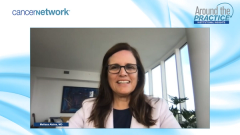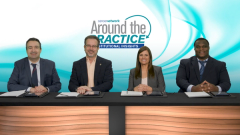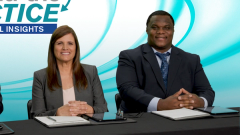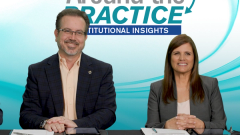
Bispecifics in the Treatment of Multiple Myeloma: Teclistamab
Panelists review data from the MajesTEC-1 clinical trial and elucidate the role of teclistamab therapy in patients with relapsed/refractory multiple myeloma.
Episodes in this series

Transcript:
Melissa Alsina, MD: Everyone knows that with immunotherapy there have been significant improvements in the treatment of myeloma because of the new agents that affect the immune system. With that, we have some bispecific antibodies. One bispecific antibody was just approved, teclistamab. It also targets BCMA, which is a protein expressed in the myeloma cells. It’s the same protein targeted by CAR [chimeric antigen receptor] T-cell therapy. Can 1 of you comment, what is the mechanism of action of these agents? How do they work, and how do they differ from CAR T? Discuss the data that led to the approval of this agent recently.
Ken Shain, MD: Who wants to volunteer?
Rachid Baz, MD: I’ll volunteer. T-cell engagers, as the name implies, engage the T cells. I think about teclistamab and other bispecific antibodies as molecules that are going to engage the T cell as well as myeloma cells at the same time. They bring them in proximity where the T cell is activated in the vicinity of the myeloma cell, and it allows immune killing by the T cells. On the other hand, with CAR T therapy, we take T cells from the patients and genetically modify them to recognize BCMA, the target. Those T cells are infused to attack the cancer. Those therapies are engaging T cells, whether the T cells have been genetically modified outside the body and infused or you’ve engaged them with a small molecule, like teclistamab or another bispecific. That’s the difference in the mechanism of action.
Those therapies are revolutionizing the field. We’re seeing unprecedented response rates in heavily pretreated patients. For example, teclistamab was approved with an overall response rate in excess of 60% in patients who have heavily pretreated disease and are triple-class exposed and, for a lot of them, triple-class refractory. The main toxicity of both therapies, CAR T and bispecific, is cytokine release syndrome [CRS], which is a marker of immune activation. Neurotoxicity is seen as well as due to immune activation. Other toxicities, which are uncommon, include myelosuppression, cytopenia, and infection.
CAR T represents an unprecedented advance with a very high response rate. We’ve seen a response rate between 70% and 95%, and some trials had a 100% response rate with deep remissions. The difference is that a bispecific antibody has to be infused at a specific schedule, and it’s not a finite treatment duration. CAR T is a 1-time therapy. Subsequently, the patient is on a treatment-free interval. That’s the main difference. There may be a time when we get to a bispecific on a finite treatment interval if certain landmarks are reached, but the data aren’t quite there. It’s extraordinary. It’s a very encouraging time, and we’re all very excited about those advances.
Melissa Alsina, MD: Absolutely.
Ken Shain, MD: It’s a revolution. When I started awhile ago, lenalidomide and bortezomib were just changing the landscape of where we are today.
Rachid Baz, MD: I thought you were going to say melphalan.
Ken Shain, MD: Wow. Essentially, they changed. All the things we’re talking about are based on lenalidomide and bortezomib and what they did in that revolution. Monoclonal antibodies, especially daratumumab, were in this in-between revolution, which added all these things [that we have] now. But we’re in a new place. These things are having untoward, unobserved effects in late relapsed disease, meaning 4 or more lines of therapy. The studies are mostly 3 or more lines of therapy, but the approvals have all been 4 or more. [They have] response rates that we wouldn’t imagine possible: MRD [minimal residual disease]–negative rate in late relapse is something we can’t hide from. It’s amazing, right?
Our job is to figure out how to get these therapies to everybody else, because they still need to be given in academic institutions that have expertise in that, especially CAR T…. With the first approval of teclistamab, it’s going to still be an inpatient [medication] for several days because of these CRS and ICANS [immune effector cell-associated neurotoxicity syndrome] potential toxicities. Our job is to figure out how we can better give them safer, so we can start doing this in more individuals.
Brandon Blue, MD: This is the wave of the future, using the body’s internal mechanisms to help fight cancer cells. For far too long, we’ve been using cytotoxic medicines that have been trying to kill cancer cells, but we have the blueprint to say that the body itself does a good job of killing other things. Let’s focus this effort and kill plasma cells. That’s where things are going. Regardless of which therapy you use, things need to be fine-tuned. We need to find the best target, and it’s probably going to be a combination of medicines that we already have vs some of the newer medicines. Maybe those combinations might unlock some extremely long progression-free survival or, dare I say, cure. It’s probably some combination of those things with what we already have, some recipe. A little bit of this, a sprinkle of that, mix the combination together, and hopefully it will lead to better outcomes in the future.
Transcript edited for clarity.
Newsletter
Stay up to date on recent advances in the multidisciplinary approach to cancer.






































































































